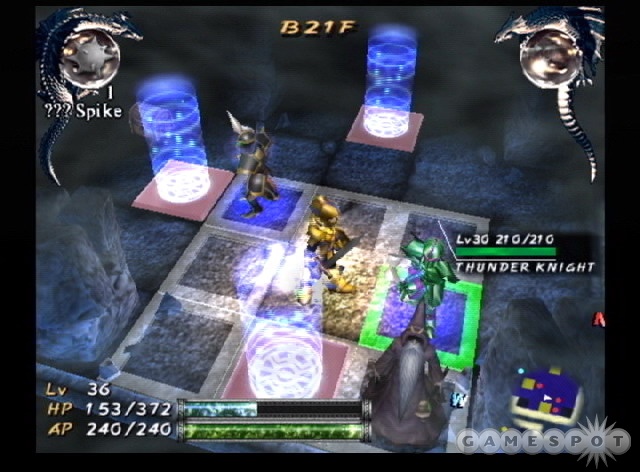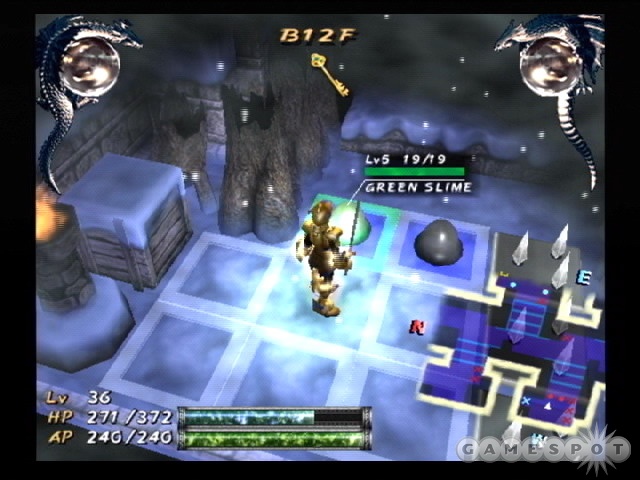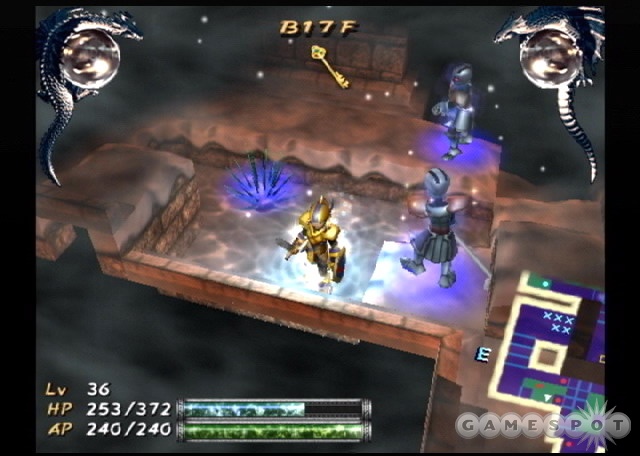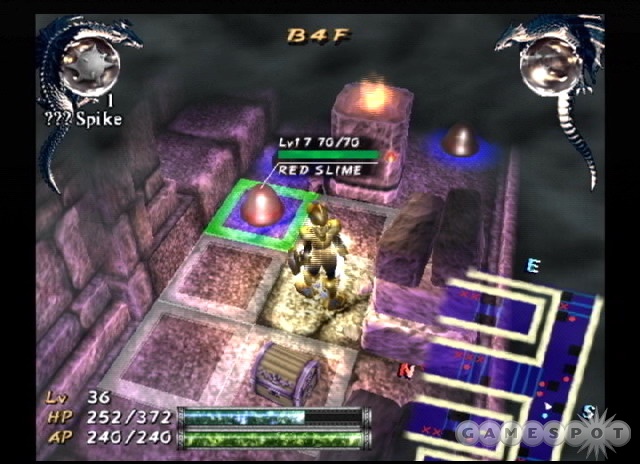Old-school dungeon crawlers are rare these days, as the ancient genre has been pushed aside in favor of turn-based role-playing games or real-time hack-and-slash action fests. It's somewhat surprising, then, to see Namco's maze-exploring title The Nightmare of Druaga creep forth into the contemporary gaming scene. Unfortunately, this game has done nothing to improve upon the well-worn dungeon hack formula, choosing instead to follow a path of mindless gameplay made more tedious by frustrating design.

The game's story picks up where the 80s arcade title The Tower of Druaga left off. The evil wizard Druaga was defeated and there was peace in the land of Babylim. Gilgamesh (or Gil), the hero who was the land's savior, is now planning to become king and to marry the lovely priestess named Ki. Everything gets derailed when there's a sudden attack and the lady Ki is whisked off into almost certain peril by a mysterious sorceress. Gil cannot let this stand, of course, and sets off to the sealed tower's basement to get his girlfriend back and smite evil as it comes.
Here's where the dungeon-crawling comes in; each floor of the mazelike underground caverns you'll explore can only be cleared by finding a key and the door to the next level. Monsters roam the halls seeking to end your adventure prematurely, and all features of the level except your immediate surroundings are shrouded in darkness. That's because Gil carries the blessing of the goddess Ishtar, which causes his burnished armor to glow with a holy light and allow him to find his way. The amount of glow will wane as you move around and explore, though you can sacrifice one of the many items you'll come across as an offering to bump your blessing back up to its maximum reach. As you move through the dungeon, a map will gradually draw itself in a corner of your screen, allowing you to navigate a bit easier, showing any nearby items, enemies, or your ultimate objectives, the key and the door.
Movement in the game is actually turn-based and not real time, so for every action you take in a dungeon, all the monsters on that floor will take a turn as well. Walking across a single patch of floor, using an item, changing your weapons, or other actions like hitting a switch, all count as a turn-- though you probably won't be concerned about these things unless an enemy is in your line of view. The enemies are color coded at their feet, which you can see as they approach; a blue glow means that Gil moves faster than the monster, while a red glow means that the enemy is faster. So, if you're right up against a blue monster, you'll always get the first attack, and the opposite is true for a red monster. The only real strategy you'll employ in battles, then, is making sure that you maneuver so that you always get the first hit. Once that's done, you just stand in one place, trade hits with your foe, slap on a healing item if you need, and you're done. Certain weapons and items you'll find can give you a bit of a longer reach, and there are special abilities imbued in your weapons that you'll be able to execute with ability points, but battle is otherwise a complete no-brainer.

The only exception is certain classes of enemies that are obscenely strong. They're always of a higher level than every other foe on the floor, they do insane damage, and once they find you, they're relentless. They won't leave you alone until you manage to leave the floor, you somehow lose them around a corner, or you're dead. The presence of these guys makes certain stages a crapshoot--you can be easily strong enough to take on the common monsters, find your stuff, and go on to the next stage so long as you simply don't encounter one of the strong creatures. If you do, and you've got heavy armor that puts you at a speed disadvantage in battle, and especially if you try to flee and find yourself hemmed in by walls and/or other enemies, you'll often just have to use an escape item and scrap that particular run. Dying in a dungeon otherwise costs you all your items (even your equipped armor and weapons) and half your money. You receive a feather each time you enter the dungeons, and the feather allows you to leave and go back to town at any time, but that means you'll have to tackle the same dungeon again from the beginning.
That random danger element just exacerbates the game's tediousness. You have to move at a measured pace through each floor of a dungeon to find the treasure chests, the key, and the door while fighting enemies. Since the majority of the battles are cake (especially once you find good sets of armor and weapons) and the enemies aren't very bright, there's not very much thrill to be had. Probably the best part of the dungeon-crawling is finding better items, but even that's not without annoyances, as special chests holding the best gear only spawn after you've cleared a floor once. Even though the main dungeons are not random, you have to draw a new map each time you revisit the floor, so you'll essentially end up having to memorize the routes to the key and door as you trudge through the same level time and again until you're finally strong enough (or lucky enough in avoiding strong monsters) to clear that particular set. The bulk of the game is a lot of mindless grinding through the same areas, stabbing the same monsters, grabbing the same key so you can move to the same door so that you can eventually move on. As fun as stabbing monsters is, the basic simplicity of the battle system and the extended repetition are enough to numb the brains of all but the most masochistic and patient.

Along with your main quest, there are some other things to do in the game; you can take quests from townspeople, and you can break down doors in dungeons. Taking a quest puts you in a special-instance dungeon for that quest, with none of your items. You'll have to win through using just what you pick up, and once you finish the quest, you can neither keep the items you gathered nor any of the experience you might have earned. The game considers this a trade-off because the quests themselves have item rewards, but this just seems needlessly punitive. In the main dungeons, once you've gone through a door once, you can choose to break the door instead of using the key on it your next time through. This sticks you in a special area with harder monsters and some nice items to be found, though you won't continue your quest until you finally move to the next floor. Hanging around town provides you with other opportunities as well: you can place items in a storehouse, get items appraised, combine items to form unique ones, and combine equippable armor and weapons to increase their strength, which can help tip odds in your favor in dungeons.
You'll autosave when entering and leaving dungeons, and if you save while in town, the game shuts itself off. That's because the game doesn't want you using reset in order to try to combine the best items, or to preserve a certain game file if you lose. (You also cannot copy the save file for the game onto the same or a different memory card.) If for some reason you reset or turn off your PS2 while playing, the goddess Ishtar will lecture you and ask you roughly 50 questions or so regarding you promising not to cheat so that you can get back into your game. You'll only forget to save once.

The game on the whole doesn't look terribly impressive. Gil himself looks blocky, jagged, and odd, particularly with armor on, and the other characters you'll meet aren't much better. The enemies feature only slightly more personality (the Godzilla-type monster that wields a sword and smashes through walls deserves mention) and a bit more detail, and they frequently swap palettes so that you'll be seeing the same basic creatures over and over again. There's a variety of underground environments you'll slog through, featuring the standard underground rivers and underground lava, as well as underground snow, underground trees, underground grass, and more. Aside from the odd stalk of grass to rustle through, the levels are all made up of bland tilesets of different colors and somewhat different textures that are serviceable, but otherwise uninteresting. The "lighting effects" in the game generally mean that what you see is limited to the light emitted by Gil, and there's no significant effect other than a blue-purple tint when things start to get dark. As far as the audio goes, it's a lot of the same repeating sound effects and understated music, which is fond of brass instruments but otherwise isn't terribly noteworthy.
The Nightmare of Druaga is a dungeon hack of the most boring kind. You'll have the most fun farming for items, but that is predicated on an enjoyment of the simplistic, dull combat, the constant repetition of dungeons, and overall tedium. There are much better ways to spend your time.